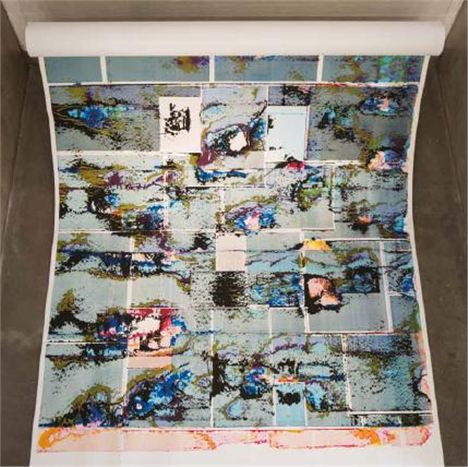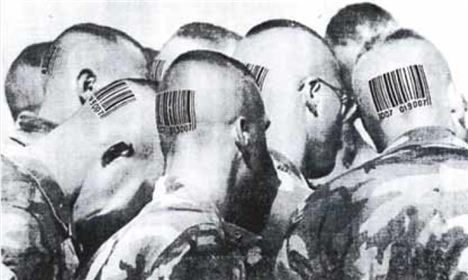THE word “scan” has a number of definitions. At the Bluecoat it currently has just one: “to cast your eye negligently over something”.
But there’s much more to the art centre’s current show than meets the eye - in every sense.
Curated by Jo Stockham (Head of Printmaking at the Royal College of Art) The Negligent Eye takes you on an engaging, sometimes mesmeric, mini-tour of the digitised expanse of current 2D and 3D scanning technologies, going right back to the world’s first scanned image in 1957 by Russell Kirsch of his baby son.
Stockham has researched how over-immersion in the space of the computer creates a sense of estrangement from the world. This exhibition engages with wider questions around the impact of digital technology on our lives. How, for instance, are scanning technologies changing how we picture and experience the world? The barcode, airport body scanners, medical scans and document scanners are all fraught with notions of both revelation and theft, while the extension of digital multiplication into cloning remains contentious.
You don’t need to be a tekkie to appreciate the images and installations on display, though it helps to understand the various processes of image transfer through digitisation. We’ve become used to these technologies in everyday life, what with domestic printer/scanners and lasers practically everywhere.
What makes this exhibition interesting is how the art world has embraced these, particularly in the established area of printmaking. Where once we had brass-rubbings, copperplate lithographs, monoprints, silk-screen and Gestetner, now we have time-lapse pixel capture, CT scans, iris-recognition, facial profiling and wireless printing.
On arrival, you can’t help but notice Maurice Carlin’s Endless Pageless. It takes up a whole wall of the gallery and grows each day using the floor space as the printing plate for its CMKY mosaic.
Close by is Conroy/Sanderson’s Fabrication installation which refers back to the digital scanners of the early 21st century. Simple idea, thoughtfully constructed, though it shows how quickly some scan technologies become obsolete in a relatively short space of time. There’s also an intriguing homage to Thomas Bewick [a celebrated 18th century engraver] which shows his own thumbprint Vignette - quite surreal, in a way, but didn’t seem to fit into the overall theme.
One particular exhibit will have you engrossed: Marilene Oliver's Family Portrait [Mum and Dad].
It’s made up of a series of MRI body slice scans which were silk-screened onto clear acrylic and reconstructed to create fully-formed, see-through bodies. It has an ethereal, ghostly impact; the closest thing you’ll ever get to having X-ray vision. It’s quite an unnerving experience – detached yet having the freedom to inspect, perhaps invade, such personal places.
Another impact occurs when you initially view Christiane Baumgartner’s Solaris 1 (main image, top). OK, you might say, it’s just another still image from a CCTV camera. Actually, it’s a single woodcut on a huge scale, which only adds to its appeal, particularly in the ironic crossover between the archaic and modern printing formats.
Good to see some local work included, courtesy of Steve Hardstaff’s South Atlantic Souvenirs collection. Individuality shows barcodes on the backs of the military forces personnel’s heads. Once again, a certain irony follows through and you wonder whether this has ever been given serious consideration within the command structure.
Given the relatively recent arrival of 3D printing, it seemed logical to include their products on display. There are a number of interesting items, but the best were Rachel Whiteread’s Secondhand and Flora Parrott’s Loop and Return. Both employ the same techniques of virtual scans delivering plastic micro build-up, yet one refers back to the domestic urban environment [a particular favourite for Whiteread] and the other is more organic as it mirrors the original ram’s horn. Almost double helix in a way, though perhaps more like alien DNA. There’s an enormous amount of scope for developments in 3D scanning and these examples indicate potential ways forward.
I’m sure that this particular crossover between art and scanning technology will provide fertile ground for budding practitioners given the potential for developments in this field. What next? Miniaturisation? Video-scanning? 4D printing? OK – that’s probably left to the likes of science-fiction which Douglas Adams would have no doubt approved. But who’s to say what might take shape over the next 20 years or so?
Finally, good to see the collaboration between Stockham, Bryan Biggs and Sara-Jayne Parsons at the Bluecoat, underpinning their common creative credentials. Their initial vision in recognising the potential of scanning technologies at the cutting-edge of artistic endeavour is amply rewarded with a remarkable range of artefacts.
View A Negligent Eye with a willingness to embrace this new groundbreaking frontier of artistic/technical enterprise.
8/10
The Negligent Eye, Bluecoat, School Lane, until June 15.
















